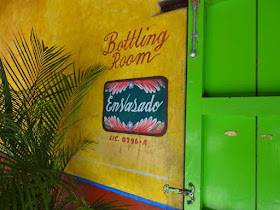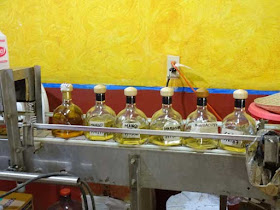The underground ovens the agave is cooked in are 140 years old.
The cooking transforms the starch into fermentable sugars, and softens the structure of the plant to make the extraction of the juices easier. The milling, or as I've been calling it grinding of the agave is done to obtain the largest possible amount of liquid sugar from the plant. The machine used to mash and extract the sugar is called a mill.
The slow and cool fermentation in the wood tanks enhances the unique qualities and characteristics of Los Osuna. Their locally developed yeast transforms the sugars into alcohol while fermenting. So that is where we were up to now.
Monday we headed out to Los Osunas Distillery again. The weeds have to be controlled as they affect the quality of the agave plant.
As we were driving in on the dirt road we passed a young man on a motorcycle he was herding the two donkeys towards the distillery. Not long after we parked in strolled the donkeys. Just taking their good old time.
They went right over to where they are harnessed to spend the day showing the tourist how the pinas used to be ground.
The big nets were drying.
The mill was quiet and sparkling clean.
The product we saw mashed the other day was starting the distilling process.
In the fermentation room the process was well under way. The Baroque Classical music was still playing but several of the oak tanks were already empty.
This barrel still had some liquid it.
The first still is copper/stainless steel, the second still is made of wood and copper, which also adds flavor. Wood stills are a unique rarity these days in Mexico. From the fermentation barrels the liquid flows to this large barrel.
The liquid in this barrel is then pumped into the first metal tank - where it is turned to steam. Then into the middle tank where it runs through coils and turns back into liquid.
All Los Osuna products are twice distilled: the first, called “destrozamiento” yields a product called “ordinario”
and the second distillation, called rectification produces the “tequila.”
The Second distillation produces the rough product at 60% alcohol/volume and has the aroma and the flavor of the
Blue Agave plant.
On of the workers explaining the process to Bill.
This tank has the coils in it where the steam is cooled enough to return to a liquid form.
A really big tank
Some of the older equipment in the building.
Each set of doors in this building leads to a room with a specific purpose.
The door on the far right is the aging room. Full of oak barrels aging the tequila.
The Blanco is then rested for 90 days before bottling.
To make Reposado, the Blanco is put into new White Oak Barrels #2 Char and aged about 11 months.
The Añejo is aged up to 3 years in the same barrels and then blended.
During the aging process the products refine its flavors and its bouquet after resting in white oak barrels. The product’s alcohol absorbs the different substances from the wood resulting in a perfect balance of texture, body, flavor and smoothness.
Next to the last room is the bottling room.

And look how we found in there. This is the bottling machine. The clean bottles line up under the spigots.
Bottles all lined up.
Hands on - Bill is pressing down on the bar that releases the liquid to fill the bottles.
The bottles are getting fuller. It stops automatically when the bottles are full.
Bottles are pushed further on line where they receive their cap.
The hands in the front right side have a small bottle of tequila, used to top off any bottle that needs it.
The next room is the labeling room. One day when we were out here several of the workers were cutting out the labels from long strips of self sticking paper.
Bottles used for training in the labeling room.
The tasting area. Usually we don't taste but this time I tried a couple of the flavored tequila.
Unfortunately - fortunately - I liked the Vanilla. It was mixed with Carnation milk and was really, really yummy. We now have a bottle of the tequila and some Carnation milk.
And that is the end of our Los Osunas adventure for this year. We will probably go there a couple more times before we go home, but probably just to visit on a slow day. Hope you enjoyed it.



























That was really awesome Carol. thanks so much for the information and, as always, the beautiful pictures. Vanilla tequila with Carnation Milk? I would definitely try it!! Merry Christmas hugs to you and Bill from White Rock BC.....not much sun and warmth here (except in our hearts)!!
ReplyDeleteHugs back. Lots of sun here, what we can see through the dust!
DeleteThank you very interesting. I also love tequila.
ReplyDeleteThank you for your comments. Means a lot to me.
DeleteYou gotta wonder how anyone figured out all that to make tequila. Lol!
ReplyDelete